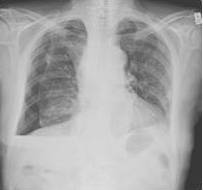Introduction
An 86-year-old retired industrial chemist presented with a four-week history of increasing breathlessness. His CXR on admission is shown in Figure 1. The presence of an air-fluid level on the right side indicates the concurrent presence of both a spontaneous pneumothorax and a pleural effusion of unknown cause: a hydropneumothorax. An intercostal chest drain was inserted, and pleural fluid sent for analysis revealed an exudate with cytology negative for malignant cells. The pleural effusion resolved with drainage, but the pneumothorax persisted. After discussion with the surgical team, he underwent video-assisted thoracoscopic surgery (VATS). This led to successful re-inflation of the lung, and the pleural biopsy preformed during the procedure revealed mesothelioma.

Figure 1: CXR Demonstrating Right-Sided Hydropneumothorax
In a second case, a 72-year-old gentleman with no known asbestos exposure presented with sudden onset pleuritic chest pain. His CXR and subsequent CT chest were consistent with a hydropneumothorax of unknown cause (Figure 2). Initial management and investigations as with our first case did not elicit a diagnosis, and his pneumothorax persisted. Resolution was achieved with VATS which also confirmed mesothelioma. He was referred to oncology for consideration of chemotherapy.

Figure 2: Hydropneumothorax on CT Chest
Discussion
Malignant pleural mesothelioma is an uncommon carcinoma. However, its causal relationship with asbestos and long latency following exposure means that its incidence is increasing. This is expected to peak in 2015 in the UK. It most commonly presents with breathlessness, chest pain, and pleural effusion on chest radiography. Spontaneous pneumothorax at presentation is less common, but with some reports suggesting a frequency as high as 10% (Seely et al., 2009). This is in comparison to primary lung cancer in which spontaneous pneumothorax is rare, occurring in 0.03%—0.05% of cases (Steinhäuslin and Cuttat, 1985). Air-fluid levels are frequently seen following partial drainage of symptomatic malignant pleural effusions including mesothelioma due to lung entrapment (Doelken, 2008). This can prevent attempts at achieving successful pleurodesis and may be managed with recurrent pleural aspirations or by insertion of indwelling pleural catheters. The occurrence of a spontaneous hydropneumothorax at presentation, however, is much less common, with very few cases reported (Hasturk et al., 2003, Wu et al., 1996). The cause is unclear, though it has been suggested that it may develop following the rupture of necrotic tumour in cases of metastatic sarcoma (Thornton and Bigelow, 1944).
Hydropneumothorax may also occur iatrogenically through the inadvertent introduction of air into the pleural space during thoracocentesis. Other differential diagnoses include bronchopleural fistula, thoracic trauma, and rarely empyema. The cause may be indicated by the history, though additional information may be obtained through imaging with CT of the chest. Further investigation and management of a hydropneumothorax involves drainage with an intercostal chest drain with fluid samples sent for standard laboratory testing including cytology. The mean diagnostic sensitivity of pleural cytology for malignancy is reported as around 60%, but this is more frequently inconclusive in cases of mesothelioma (Hooper et al., 2010). Tumour markers currently do not have a proven role in the routine investigation of pleural effusions. However, molecular tools such as fluorescence in-situ hybridisation which have been shown to increase the diagnostic yield of pleural cytology may play a role in the future (Fiegl, 2005). Where initial investigations have failed to reveal a diagnosis, and in cases where resolution has not been achieved, VATS can be invaluable.
The development of hydropneumothorax outside the context of trauma and pleural intervention is uncommon, but there is an association with malignant pleural mesothelioma and the diagnosis must therefore be considered in the differential diagnosis.
Conclusion
Malignant mesothelioma frequently presents with a pleural effusion, and less commonly it can present with a spontaneous pneumothorax. Spontaneous hydropneumothorax is a rare presentation of mesothelioma but must be considered as a part of the differential diagnosis. Where the diagnosis is suspected, VATS can be useful where initial investigations have failed.
References
Doelken, P. (2008). “Clinical Implications of Unexpandable Lung due to Pleural Disease,” American Journal of the Medical Sciences, 335(1), 21-25.
Publisher – Google Scholar
Fiegl, M. (2005). “The Utility of Fluorescence in-Situ Hybridization in the Diagnosis of Malignant Pleural Effusion,”Current Opinion in Pulmonary Medicine, 11(4), 313-318.
Publisher – Google Scholar
Hasturk, S., Hanta, I. & Karatash, M. (2003). “Spontaneous Hydropneumothorax: An Unusual Presentation of Malignant Pleural Mesothelioma,” Turkish Respiratory Journal, 3(3), 127-129.
Publisher – Google Scholar
Hooper, C., Lee, Y. C. G., Maskell, N. & Grp, B. T. S. P. G. (2010). “Investigation of a Unilateral Pleural Effusion in Adults: British Thoracic Society Pleural Disease Guideline 2010,” Thorax, 65, 4-17.
Publisher – Google Scholar
Seely, J. M., Nguyen, E. T., Churg, A. M. & Müller, N. L. (2009). “Malignant Pleural Mesothelioma: Computed Tomography and Correlation with Histology,” European Journal of Radiology, 70(3), 485-91.
Publisher – Google Scholar
Steinhäuslin, C. A. & Cuttat, J. F. (1985). “Spontaneous Pneumothorax. A Complication of Lung Cancer?,” Chest, 88(5), 709-13.
Publisher – Google Scholar
Thornton, T. F. & Bigelow, R. R. (1944). ‘Pneumothorax due to Metastatic Sarcoma,’ – Report of Two Cases, Archives of Pathology, 37(5), 0334-0336.
Google Scholar
Wu, H., Tino, G., Gannon, F. H., Kaiser, L. R. & Pietra, G. G. (1996). “Lepidic Intrapulmonary Growth of Malignant Mesothelioma Presenting as Recurrent Hydropneumothorax,” Human Pathology, 27(9), 989-92.
Publisher – Google Scholar





